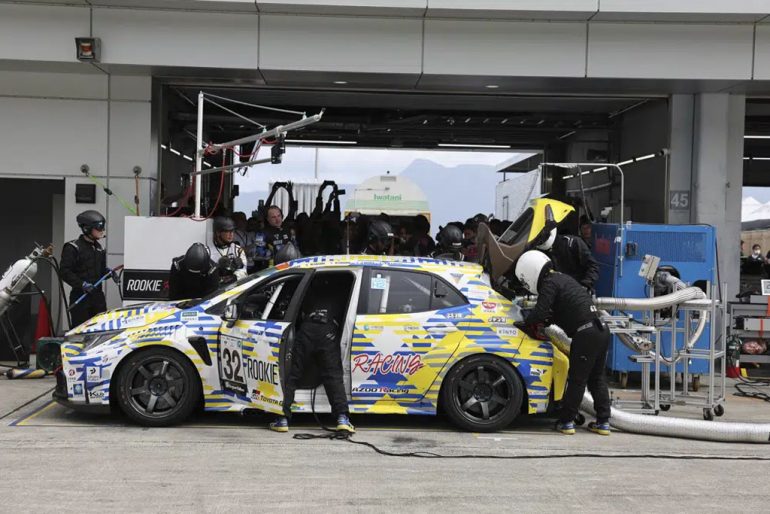
In a groundbreaking move to showcase their commitment to developing environmentally friendly vehicles, Toyota has introduced a liquid hydrogen-powered Corolla race car at a circuit near Mount Fuji in Oyama, Japan. The debut of this hydrogen-fueled vehicle in racing marks a significant step towards incorporating futuristic technologies in the racing world.
Akio Toyoda, the Chairman of Toyota, donned a fire-resistant racing uniform and exuded enthusiasm as he prepared to drive the hydrogen Corolla around the circuit. As a former CEO of Toyota, a licensed race driver, and the grandson of the automaker’s founder, Toyoda expressed his hopes that the liquid hydrogen car’s participation in the race would provide an alternative in the battle against global warming. He aimed to bring smiles to everyone’s faces by going one lap, even just one second, further.
However, it is important to note that the hydrogen Corolla race car is not intended for commercial release in the near future. Toyota officials clarified that its participation in the Super Taikyu 24-hour race at Fuji Speedway was solely a test to showcase the potential of the technology.

While electric vehicles have gained significant traction in the automotive industry, Toyota has focused on hydrogen as a potential carbon-neutral solution. Despite falling behind in the global shift towards battery-powered EVs, Toyota, a Japanese automaker that sells approximately 10 million vehicles annually, believes in the great potential of hydrogen. Experts agree that hydrogen holds promise, but the current production of hydrogen, including that used to fuel the Corolla race car, primarily relies on fossil fuels such as natural gas.
The rising fuel prices and mounting concerns over global warming have fueled the search for alternative energy sources, particularly in Japan, a country that imports the majority of its oil. Auto racing has also begun to move away from traditional gas-guzzlers. Honda Motor Co., a rival of Toyota, recently announced its return to Formula One racing, viewing new regulations as an opportunity for technological research. Similarly, other automakers like General Motors Co. have made similar commitments.

During the event, Pierre Fillon, the president of the Automobile Club de l’Ouest, which organizes the famous 24 Hours of Le Mans endurance race, announced that hydrogen-powered cars, utilizing both fuel cells and combustion engines, would be eligible to participate in the race starting in 2026. Fillon emphasized the importance of transitioning to zero-emissions mobility for the sake of the planet and future generations.
Toyota’s Chief Executive, Koji Sato, expressed his desire to make an announcement soon regarding Toyota’s potential participation in Le Mans. The discussion on green-energy solutions is still in its early stages, as noted by John Heywood, a professor emeritus and automotive engine expert at MIT. Heywood highlights that internal combustion engines can be environmentally friendly depending on the fuel used. The challenge lies in creating an environment that fosters hydrogen usage and ensures its widespread adoption, encompassing transportation and production processes.
In terms of hydrogen production, the hydrogen utilized for Toyota’s race car is sourced from a coal gasification plant in Australia and delivered by Iwatani Corp., a Japanese energy company. This project is supported by the Japanese government, aiming to promote hydrogen use across various industries that currently rely on fossil fuels. Green hydrogen, on the other hand, is created through electrolysis, powered by renewable energy sources, separating hydrogen and oxygen molecules in water without producing carbon dioxide. However, less than 0.1% of global hydrogen production currently follows this eco-friendly process, according to the IEA.

Critics argue that it might be more beneficial to directly utilize renewable energy instead of converting it into hydrogen. However, proponents of hydrogen argue that even when produced from natural gas, it can be environmentally sound if carbon emissions are captured and stored underground.
While the debut of liquid hydrogen in racing represents progress, there are challenges to overcome. In a previous test run at the Suzuka circuit, a Toyota vehicle fueled by liquid hydrogen caught fire due to a loosened pipe caused by vibrations. Fortunately, the leak sensor functioned properly, shutting off the hydrogen within milliseconds and preventing any injuries. Toyota ensured the safety of the cabin and contained the fire.
In the Fuji Speedway 24-hour race, Toyota’s No. 32 Corolla faced challenges that led to its inevitable loss. Refueling and pit checks, vital aspects of racing, took a considerable amount of time, which proved detrimental in a race where competitors vie for every second.
Despite these challenges, Tomoya Takahashi, the president of Toyota’s Gazoo Racing Co., believes that this endeavor signifies a step towards building for the future. He emphasized that electric cars are not the sole solution and highlighted the potential of internal combustion engines.
The integration of liquid hydrogen technology in racing demonstrates Toyota’s determination to develop green vehicles and explore alternative energy sources. While the path to widespread adoption of hydrogen-powered vehicles remains complex, these advancements in the racing world signify progress towards a more sustainable future.
Source: APNews

Lloyd Tobias is a seasoned automotive journalist and passionate enthusiast with over 15 years of experience immersed in the world of cars. Whether it’s exploring the latest advancements in automotive technology or keeping a close pulse on breaking industry news, Lloyd brings a sharp perspective and a deep appreciation for all things automotive. His writing blends technical insight with real-world enthusiasm, making his contributions both informative and engaging for readers who share his love for the drive. When he’s not behind the keyboard or under the hood, Lloyd enjoys test driving the newest models and staying ahead of the curve in an ever-evolving automotive landscape.